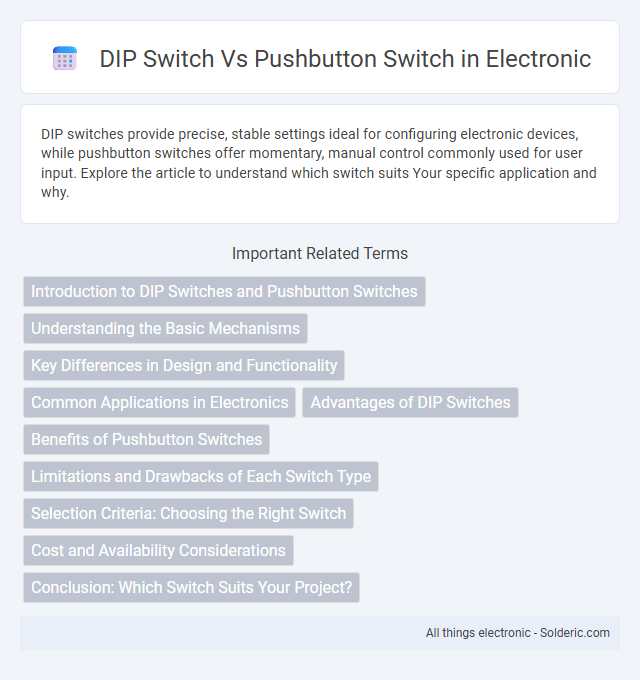DIP switches provide precise, stable settings ideal for configuring electronic devices, while pushbutton switches offer momentary, manual control commonly used for user input. Explore the article to understand which switch suits Your specific application and why.
Comparison Table
| Feature | DIP Switch | Pushbutton Switch |
|---|---|---|
| Function | Manual binary data input, on/off settings | Momentary electrical circuit activation |
| Operation | Toggle switch positions (on/off) | Press and release action |
| Use Case | Configuration settings, hardware addressing | User input, reset or control signals |
| State | Maintains position until manually changed | Returns to default after release |
| Size | Small, multi-switch package | Varies, usually compact |
| Installation | PCB mounted, DIP format | Panel or PCB mounted |
| Examples | Setting device addresses on communication boards | Reset button on electronics, doorbell switch |
Introduction to DIP Switches and Pushbutton Switches
DIP switches are compact, manual electrical switches often used to configure settings on circuit boards by toggling individual switch positions. Pushbutton switches provide momentary contact through a button press, commonly used for user inputs and control functions in electronic devices. Understanding your application's need for either configuration settings or momentary control helps determine whether a DIP switch or pushbutton switch is most suitable.
Understanding the Basic Mechanisms
DIP switches use a series of small toggle switches encased in a dual in-line package, allowing you to set binary input configurations manually by sliding each switch to an ON or OFF position. Pushbutton switches operate by physically pressing a button to complete or interrupt an electrical circuit, often returning to their default position when released. Understanding these basic mechanisms helps you select the appropriate switch type for configuring devices or user input interfaces.
Key Differences in Design and Functionality
DIP switches are compact, multi-position switches designed for configuring circuit settings by toggling individual switches on or off, typically used on printed circuit boards for binary inputs. Pushbutton switches are momentary or latching switches that allow user interaction through pressing, commonly used for manual control or resetting functions. The primary design difference lies in DIP switches' fixed, stable configuration versus pushbutton switches' dynamic, user-activated operation.
Common Applications in Electronics
DIP switches are commonly used for setting hardware configurations in devices like motherboards, remote controls, and industrial equipment due to their compact design and ease of integration. Pushbutton switches are prevalent in user interfaces for consumer electronics, such as keyboards, calculators, and reset functions, where momentary or tactile input is required. Both switches play critical roles in controlling circuit functions but are selected based on the need for permanent settings versus temporary user input.
Advantages of DIP Switches
DIP switches offer reliable and compact solutions for setting configurations in electronic devices, enabling multiple binary options within a small footprint. Their non-volatile nature ensures that settings remain intact without power, making them ideal for permanent or semi-permanent adjustments. You benefit from easy customization, cost-effectiveness, and durability compared to pushbutton switches, which typically provide momentary contact and require continuous user input.
Benefits of Pushbutton Switches
Pushbutton switches offer fast, reliable operation with simple tactile feedback, making them ideal for quick user input in electronics and control panels. Their compact design supports multiple functions in a small footprint, enhancing device usability. You benefit from easy installation and durable performance, especially in applications requiring frequent manual activation.
Limitations and Drawbacks of Each Switch Type
DIP switches have limitations including limited current capacity, susceptibility to dust and mechanical wear, and difficulty in making rapid changes due to their manual toggle design. Pushbutton switches may suffer from contact bounce, limited lifespan under high usage, and potential for accidental activation without protective measures. Your choice between DIP and pushbutton switches depends on the specific application requirements, such as durability, ease of use, and electrical load handling.
Selection Criteria: Choosing the Right Switch
When choosing between a DIP switch and a pushbutton switch, consider your application's needs for configuration versus momentary input. DIP switches provide reliable multi-position settings ideal for device configuration, while pushbutton switches suit temporary user inputs or resets. Your selection should factor in factors like switch durability, installation space, and the frequency of operation to ensure optimal performance.
Cost and Availability Considerations
DIP switches generally offer a lower cost and wide availability due to their simple design and widespread use in electronic devices, making them ideal for budget-conscious projects. Pushbutton switches tend to be slightly more expensive owing to their mechanical complexity and are commonly stocked in various sizes and actuation styles, ensuring availability for different applications. Your choice between the two should consider not only initial cost but also the required durability and ease of integration in your specific use case.
Conclusion: Which Switch Suits Your Project?
DIP switches offer precise settings and compact control for digital configurations, making them ideal for circuit customization and programming. Pushbutton switches provide tactile feedback and momentary control, suited for user interfaces requiring quick, repeated input. Choose DIP switches for stable, preset configurations and pushbutton switches for interactive, on-demand operation in your project.
DIP switch vs Pushbutton switch Infographic

 solderic.com
solderic.com